Back in September, I wrote about The Mulkay Manikay Archives and promised to share more detailed information about the Dhalinybuy CD. Here we go!
I’ve talked a lot about Dhalinybuy since this blog started last April, mostly in the series of posts about the short film Two Brothers at Galarra. The families of the late Mathuḻu Munyarryun embraced the creative potential of the Mulka Project’s new media facilities before other local Yolŋu. They pitched the first film idea outside of a workshop and recorded the first CD within a month of Mulka’s official launch.
The Session
On 31 August 2007, I drove out to Dhalinybuy with Mulka’s first two employees, Ḏiṉḏirrk Munŋgurr and Ṉuwaniny Burarrwaŋa, some basic recording and filming equipment, and a bunch of food. We began with the senior singers, Malalakpuy and Wakaŋ, supervised and sometimes joined by Mathuḻu, along with the late Mirrwatŋa on yidaki.
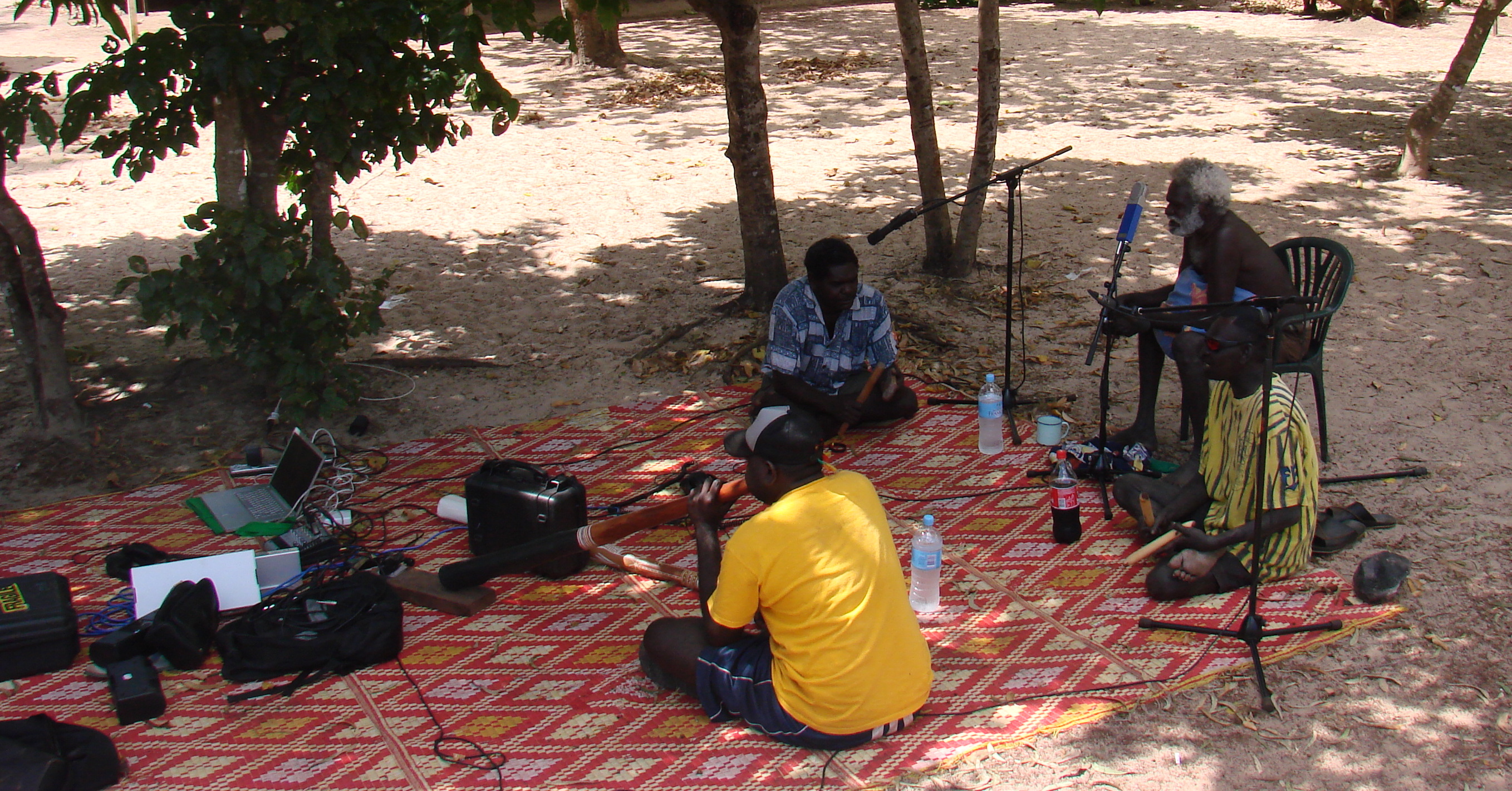
Listen to what happened from there on the CD, which is available from all the usual digital music retailers and from several yidaki sellers around the world. Here’s one sample.
Baltha
After the recording, I asked Mathuḻu, “what will this CD be called? What will the album cover be?”
He only had to think for a few seconds. The title would be Baltha. Baltha, the Wangurri clan thundercloud which they sang at the beginning and end of the cycle we just recorded. He described the shape of it for me. He explained that they sang the journey of water from where we sat near the river Gularri to the sea, where it is sucked up by Baltha and rained down on the land to begin the journey again. They sing this cycle at funeral ceremony, the story of water paralleling the story of the human soul. The cover image would be a photograph of the cloud called Baltha.
While I loved the idea, I didn’t like my chances of pulling it off. I thought, “How am I supposed to get a picture of that? Call the Bureau of Meteorology and describe it to them, hoping they’ve got an archive of cloud photos?”
But I didn’t have to. Not long after the recording session, funeral ceremony was underway at Dhalinybuy. These ceremonies can last for weeks or even months. On 6 November, all of us at Yirrkala knew the funeral was wrapping up. My wife and I were out for a walk at sunset, looked in the direction of Dhalinybuy, and there it was. Baltha. Rising over the sea in Arnhem Bay. Possibly just as they were singing the end of this song cycle to conclude the ceremony.
I snapped a bunch of pictures and showed them to Mathuḻu at my next opportunity. He said, “yes, that’s it. That’s the cover.”
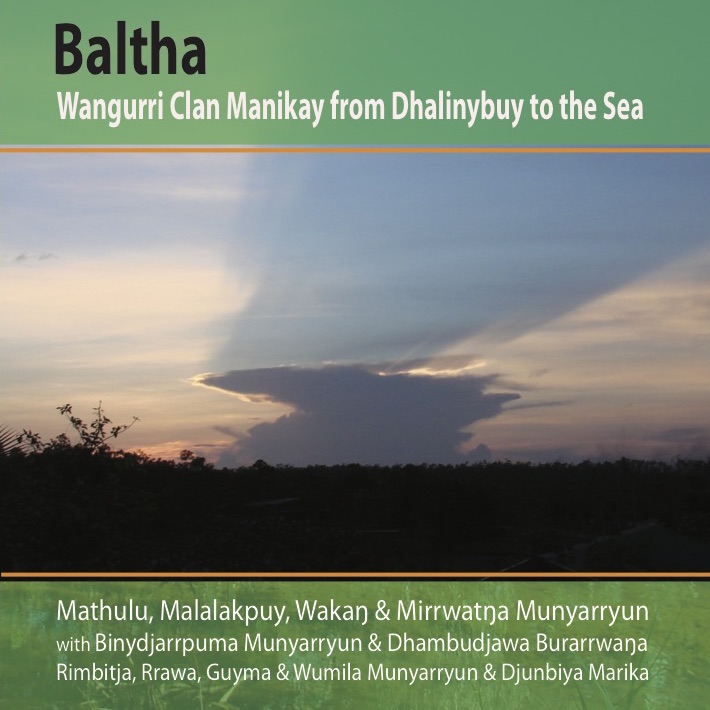
the old man tells the story
As I said in my prior blog post about the CD series, the late founding Mulka Project Director, Dr. Raymattja Marika, and I had big plans for the liner notes. We wanted to show up every outsider academic who published recordings of Aboriginal music. Dr. Marika sadly passed away suddenly before we finished the process on any of the three CDs we had recorded, then I suddenly had to leave Yirrkala due to my own family medical crisis. Those three CDs and several more in the end were released with simplified titles and no information other than track and artist names. I do have the recording and text of the late Mathuḻu telling the story as he wanted it in the liner notes, so will share those with you all now. The late Margaret Yunupiŋu and I did the basic transcription and translation, which was then polished with help from Dr. Marika and the late (wow, I have to say that a lot) Gulumbu Yunupiŋu.
Tracks 1-7 on the final version are archival recordings, some of which are discussed thoroughly here.
Tracks 8-12 Baltha
| Ŋunha nhän ga dhäya mayali’ dharyundawu. Murrun nhän Ŋarru ga dharyun nhän ŋarru. Ŋunhan nhän ga mayali’ miyaman dhaŋuyam Baltha. | That cloud standing there shows that rain is coming. There will be thunder and rain. These songs are about the cloud called Baltha. |
Tracks 13-21 Gulŋura (Lightning)/Maḻurrk (Rain)
|
Yow, Baltha ŋunha nhän gayŋan ḏurruwan ŋarran Baltha, banha ga bunbuwanam nhän bala dharyuwanan. Dharyuwanan nhän bäŋnha bayman goḻurr. Bala nhän ŋarru dhuṉiyan garmak bayiwaḻiya dharyundawuy maḻwurrkkuŋ. Ŋunha murruyil’, manymak murruyil buṯthuwan ŋuymurru maḻurrkkuŋ dharyunda ŋuymurru nhanguru. Yow, dharyuwanan nhän buṯthuwanan djukdjukthuwanan bitjan bayiŋ yolŋuya. Ga bilinya dhuwanma dhäwu. |
The cloud Baltha is forming, rising up. It begins to rain on the cycad palm leaves and the ground of the valleys. The valleys and rivers begin to flood from the rain. Murruyil the pigeon flies through the rain to get away from the storm. It fled from the rain, soaking wet, like Yolŋu People would. That’s the story. |
Tracks 22-30 Murruyil (Pigeon)/Meṉḏuŋ (Snail)
|
Yow, ŋunha dharyuwan nhän ga manymak buṯthuwan murruyil’ dharyunda, dharyunda buṯthuwan murruyil’ djukdjukthuwan ga manymak after bayiwaḻiya murruyil’ŋuru nhän ŋätjin rirrakay’yuwan maypaḻ meṉḏuŋ yäku gunaminy. |
It was raining, the pigeon flies through the rain, soaking wet, and after that, the snail gunaminy cries out. |
Tracks 31-34 Ŋerrk (White Cockatoo)
|
Ga bayiwaḻiyam ga nhän buṯthuwan ŋerrk’nha ga ŋerrk’nha ḏurruwan ḏinguŋuru bäŋŋuru ŋayakandi dhopaṉŋuru. Nhän ḏurruwan ŋerrk, ŋarru wäyinma banha nhän wanhurr nininyŋu bawarraṉ ga dhaŋuya waŋganyma dhäwu. |
From there, the white cockatoo flies away from the cycad palms, where it lives. That’s one part of the story. |
Tracks 35-39 Warrkarr (Grass)
Note: Mathuḻu originally named this section Bulmirri. another name for the grass that he used in his story.
|
Yow, dhaŋu dhäwu banhaya dharyunda, dharyuwan nhän nhanam yuṯa dhawaṯthuwan ḏukitj muḻmu, wokara, nhän yindim yäku wokara, bulmirri. Nhän dhawaṯthuwan yuṯa djupaḻ dharpa gaṉakaṉa. Yuṯa dharyunda. Ḏukitj wulaynha dhawaṯthuwan. Wo ḏingu. Yuṯan ŋarran dhawayawaṯthuwan, ŋätjilim nhän guwaruwan ga banham nhän dharyuwanam nhän yuṯam dhawaṯthuwan. Muḻmu, dharpa banha yuṯan dhawaṯthuwan dhamany’tjuwan. Bilanya dhäwu. |
In this next part of the story, it rains, then the new shoots of grasses come out. The razor grass – the special name for that is wokara or bulmirri. Those two come out, the razor grass and the stringybark trees. New growth from the rain, the grasses come out. And the cycad palms. The old plants were burned, but when the rain comes, the new growth comes up. The new grasses and trees grow up. That’s the story. |
Tracks 40-51 Gapu (Water)
Note: Mathuḻu originally called this section Guḻarri after the specific water course, rather than Gapu, which is the general word for all water.
|
Yow, dhaŋu manikay garmak bayikuwuy dharyunda dhaŋum garmak bayikuwuy dharyunda banhan nhän dharyuwan dhaŋu nhän ŋarru dhuniyan baḻaya wunhanha ŋuḻŋuḻyun ŋarru nhän dhuniya guryun djarrawuryun Guḻarri. |
This song is about the water from that rain, which comes down through the plants and becomes the rushing currents of the river Guḻarri in flood. |
An Additional Note from Mathuḻu at this Point In the Recording
|
Yow, dhuwanma nhän waripuyi nhän bilyuwan muḻkurr. Muḻkurr ga ŋäṉarr. Ga garmak ŋarru nhän betjdjinan garmak, dhuniyanan. Betjna garmak ṉikundayinan ḻiŋgun. Dhuwaniyan garmak. Yow, waŋganydji yulŋum, ŋätjilim nhän biḻma, bala ḏirruwan waŋgalalin ga dhuwanmanam dhä-wupalin ḏirruwan gayawak mayali’ nhan manikay. |
Now we are turning our minds to another part of the story. Our minds and our tongues. The water is calming, becoming more still as it flows down river. This water (Guḻarri) has become calm. It is all the same thing, the same old song, but as it returns to our country where the fresh and salt waters meet, the melody changes. |
Tracks 52-58 Man’tjarr (Mangrove Leaves)
|
Man’tjarr, miyaman man’tjarr. Man’tjarr wokundurr gulam ŋarram dhaḻaḻyun. Ŋunhayam manikay ŋandjaḻa’yuwan djupal. Bilanya. |
Leaves, singing the leaves. The leaves, branches and grasses washed out by the storm are flowing down the river. The singers turned the song around to this. |
Tracks 59-66 Balin (Barramundi)
|
Barramundi, this manikay. Balin. Ratjuk manikay ŋarru yindin. Riŋgitjin nhana rakaram dhäyanhara dhawurrḻi. Djuṉmili nhän ḏam’thun gayŋa guwaman man’tjarr ḏuniyanhara. Biyapul Guḻarri wambal guwaman. Djaykurrŋa Guyuwuruyu. Banatja nhän dham. Ŋayawuḻuḻ Biruyuwanan nhän dhurrwaram. Ga ratjuk bawalamiyu bayiŋ guwaman ratjuk bilinya bitjan ŋuykal. |
This song is about the barramundi, we call Balin or Ratjuk. This is the very sacred song for barramundi. The faster clapsticks signify that we have reached where all the leaves and plant material washed downstream by the storm have gathered up in the still water. The barramundi is biting at the leaves and drinking the water of the bottom of the river. The mouth of the barramundi in the water called Djakurrŋa Guyuwuruyu. Ŋayawuḻuḻ, Biruyuwanan are important names for the barramundi’s mouth. Everyone eats the barramundi, just like the kingfish. |
Tracks 67-69 Watpirriya (Archer Fish)
|
Yow, waṯpirriya manikay. Waṯpirriya manikay baya nhän bayiŋ ŋoya, buryun. Dhawurrŋa djuṉmiliŋa nhän bayiŋ ŋoya. Ga bulu nhän bayiŋ makaŋa, gunydjakŋa ŋoya waṯpirriya nhanbayi, dhuwaniya manikay. |
This is the song of the freshwater mullet waṯpirriya. The song of where waṯpirriya lie, splashing in the water. Where the leaves and branches are bunched up. Lying at the roots of the Yirritja pandanus. That is this song. |
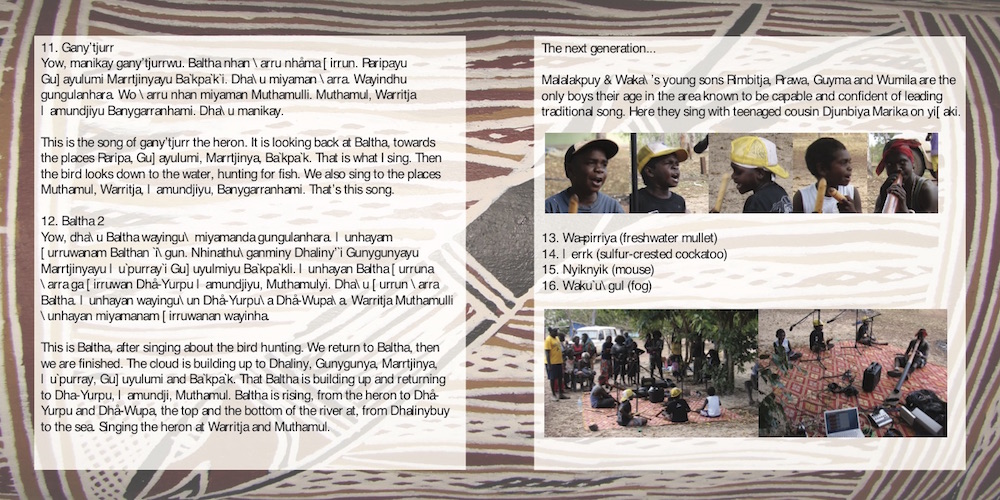
Tracks 70-76 Gomuḻu (Heron)
Note: Mathuḻu used another name for the heron, Gany’tjurr. Which incidentally, is one of my given Yolŋu names.
|
Yow, manikay gany’tjurrwu. Gany’tjurr Baltha nhän ŋarru nhäma ḏirrun. Raripayu Guṉuyulumi Marrtjinyayu Baḻkpaḻkḻi. Dhaŋu miyaman ŋarra. Wayindhu gungulanhara. Wo ŋarru nhan miyaman Muthamulli. Muthamul, Warritja Ŋamundjiyu Banygarranhami. Dhaŋu manikay. |
This is the song of gany’tjurr the heron. It is looking back at Baltha, towards the places Raripa, Guṉuyulumi, Marrtjinya, Baḻkpaḻk. That is what I sing. Then the bird looks down to the water, hunting for fish. We also sing to the places Muthamul, Warritja, Ŋamundjiyu, Banygarranhami. That’s this song. |
Tracks 77-81 Baltha
|
Yow, dhaŋu Baltha wayinguŋ miyamanda gungulanhara. Ŋunhayam ḏurruwanam Balthan ḻiŋgun. Nhinathuŋganminy Dhaliny’ḻi Gunygunyayu Marrtjinyayu Ŋuḻpurrayḻi Guṉuyulmiyu Baḻkpaḻkli. Ŋunhayan Baltha ḏurruna ŋarra ga ḏirruwan Dhä-Yurpu Ŋamundjiyu, Muthamulyi. Dhaŋu ḏurrun ŋarra Baltha. Ŋunhayan wayinguŋun Dhä-Yurpu Dhä-Wupaŋa. Warritja Muthamulli ŋunhayan miyamanam ḏirruwanan wayinha. |
This is Baltha, after singing about the bird hunting. We return to Baltha, then we are finished. The cloud is building up to Dhaliny, Gunygunya, Marrtjinya, Ŋuḻpurray, Guṉuyulumi and Baḻkpaḻk. That Baltha is building up and returning to Dha-Yurpu, Ŋamundji, Muthamul. Baltha is rising. From the heron to Dhä-Yurpu and Dhä-Wupa, the top and the bottom of the river. Singing the heron at Warritja and Muthamul. |
There you go
There was meant to be more written to flesh out the context, but this has been what the senior man of the family wanted to tell all of you out in the world about what was happening in the songs. I hope that if you have the album, this brings you some new appreciation of it. If you haven’t bought it, I hope you do.
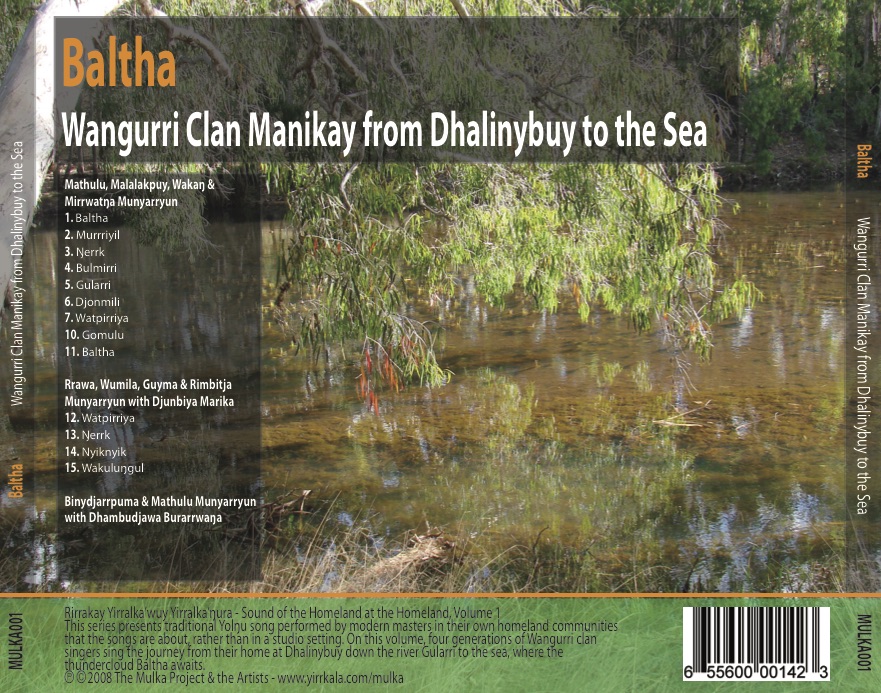

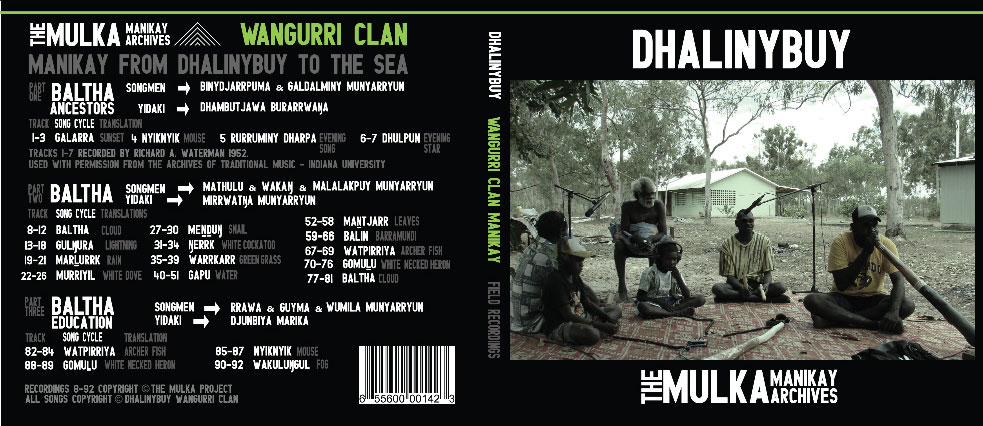
Yes, of course i want it :).
Another fantastic chapter, Randy! Thanks again.
Very nice insight into the recordings, thanks Randin!
I just re-read this material. Wonderful!!! Too bad it wasn’t published as planned.
Is there a “lyric booklet” for any of these songs??
I need to start learning Wangurri matha and songs help me learn 🙂
Nope. And manikay lyrics won’t be a great way to start on a language. It’s pretty esoteric stuff, usually, lists of sacred names and such. Not conversational at all. If you’re not already onto it, look at thi! https://bookshop.cdu.edu.au/products/9781925167375
And the Mulka Project film ‘Two Brothers at Galarra’ which has subtitled speech, and yes, some song, too.